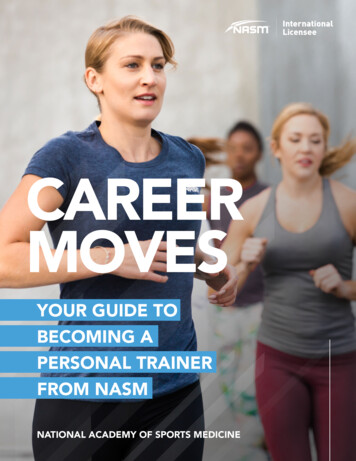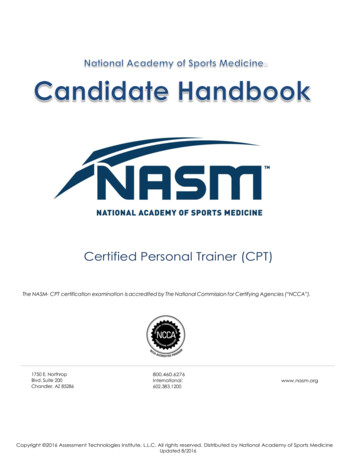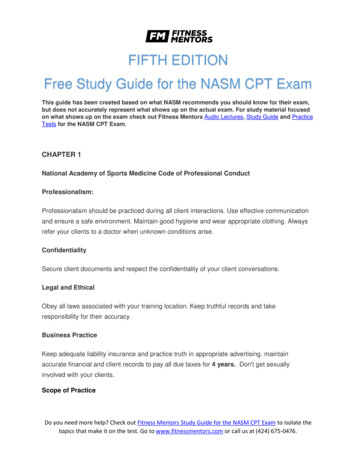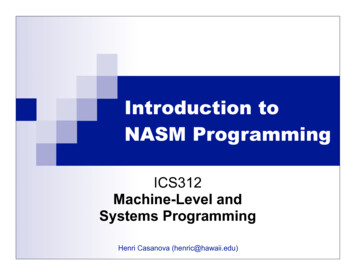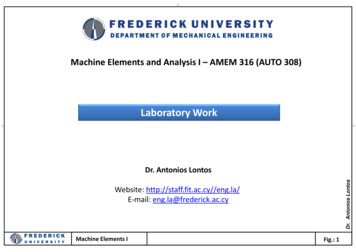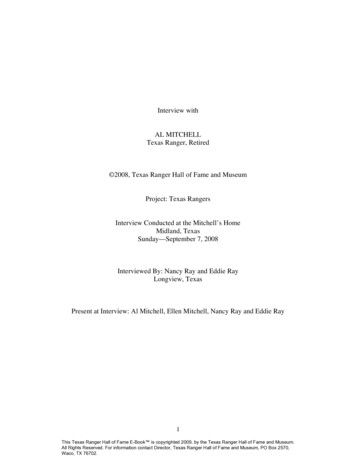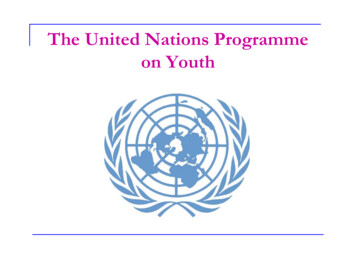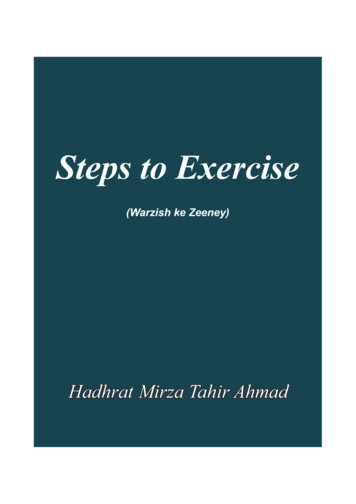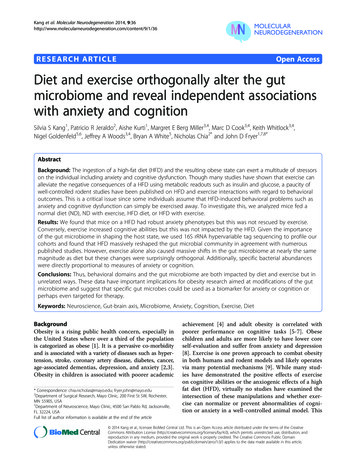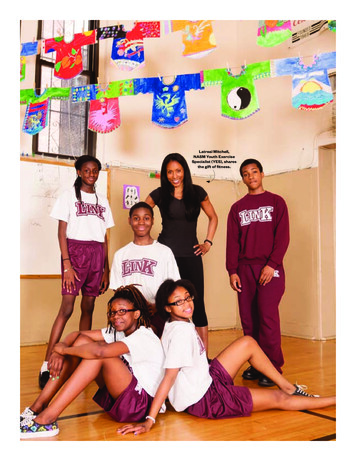
Transcription
Latreal Mitchell,NASM Youth ExerciseSpecialist (YES), sharesthe gift of fitness.NASMFA13 youth layout [P].indd 108/8/13 2:14 PM08082013141735
sayYESto youthWith childhood obesity on the rise and in-schoolphysical education programs under siege, you can makea difference, for children and your business.by michael woelfleinnphotography by dustin fenstermacherMore than one-third of U.S. children and adolescents are overweightor obese. The obesity rate for 6- to 19-year-olds more than doubled from 1980 to 2010,to about 18%, according to the Centers for Disease Control and Prevention. Meanwhile,schools are cutting physical education in the face of budget problems and lax regulations.The Department of Health and Human Services recommends at least 60 minutes ofphysical activity every day for youths—including aerobic, muscle strengthening, andbone strengthening exercises—but only six states require 150 minutes per week inelementary schools, and even fewer push for enough exercise for older kids. It’s an ugly setof numbers, because exercise helps kids live happier lives, avoid disease, and even performbetter academically. But it also means there’s an opportunity for fitness and sports medicineprofessionals to step in and help.NASM.ORG / 11NASMFA13 youth layout [P].indd 118/14/13 5:06 PM08142013170642
A Hero for the MassesLatreal Mitchell, NASM-CPT, CES, YES (YouthExercise Specialist), is doing her part. Everyweekday in July, Mitchell led two-hour workoutsand nutrition/healthy living sessions for 80 kidsat the Link Community School in Newark, N.J.“They get it,” she says. “They say, ‘Wow,what am I doing to myself—creating diabetesand bad habits?’ You see that aha moment, andit’s awesome. They tell their parents, ‘Don’t dothat’—and why. It’s empowerment from thebottom up.”Mitchell is thinking bigger too. She createda cartoon team of kid superheroes, The FitnessBunch , who empower children to exercise, eathealthier, and make smart choices. It’s now anonprofit foundation (fitnessbunch.org) andMitchell hopes to publish her first book in 2014,starring Kidd Fantastic .“We’re going to reach the masses, the kidswho really need us, wherever they are,” Mitchellsays. “We want to create a place for kids to go forthe support they need.”The personal trainer/lifestyle coach to former NFL (and current morning TV) superstarMichael Strahan first took up the cause in 2000,long before youth obesity and fitness became ahot topic. Mitchell developed and ran a summerFit Academy for Kids in the Los Angeles areafor four years, helping hundreds of kids, withsupport from the local chapter of the AmericanHeart Association. She’s also spoken at schools.It all started when Mitchell was working ata Los Angeles–area gym and an 11-year-old girlasked her for help to make the school’s trackteam. The girl’s mother couldn’t pay for trainingbut didn’t want a handout, and the daughterdidn’t make the team.Mitchell revels in that aha moment when kids likethese at the Link Community School in Newark,N.J., “get it” and understand the power (and fun) ofhealthy living for themselves and their families.What the Science SaysSimple Steps, Big BenefitsExercise helps kids and teens in sports, life, and even the classroom.Strong for life Regular physical activity makes youths stronger,improves their endurance, and helps them build and maintain healthybones and muscles. “I love to see the awkward kids become lessawkward, learn how to move,” says Latreal Mitchell, NASM-CPT, CES,YES. “Learning about this now is going to change their lives.”Freedom from disease and depression Regular exercisedecreases the risk of a long list of diseases and conditions, includingobesity, diabetes, heart disease, depression, anxiety, and certaincancers. “When kids exercise, good things happen,” says Mary C.Friesz, PhD, RD, CDE, LDN. “It’s as simple as that.”A thoughtful generation Studies show that regular exercisemay improve cognitive skills, study habits, personal conduct,grades, and test scores. John J. Ratey, MD, a clinical associateprofessor of psychiatry at Harvard Medical School and author ofSpark: The Revolutionary New Science of Exercise and the Brain,has made physical education his life’s work. He points to Naperville,Ill., where a fitness-based, in-school program has helped reduceoverweight kids to 3% of the population, and helped the schoolplace No. 1 on a worldwide standardized test for science and No. 6 inmath. “Exercise turns on the brain,” Dr. Ratey says. “It makes thelearner ready to learn. It makes our brain cells ready to do whatthey’re supposed to do, and it promotes the growth of new braincells. It’s amazing. With a little bit of exercise, we can affect so manypeople. We can change our culture. Really.”12 / THE TRAINING EDGENASMFA13 youth layout [P].indd 128/8/13 2:14 PM08082013141853
slrr,arahntlkgre,f.NASM.ORG / 13NASMFA13 youth layout [P].indd 138/14/13 5:06 PM08142013170647
Keys to ameaningful youthfitness program:fun, integration,progression, andparentalinvolvement.“I saw a kid miss out on something she reallywanted at that age,” Mitchell says. “I knew thenthat kids were going to need help.”try thisLink Up with Kids Who Need YouLooking to partner with schools or community programs?Have a plan. “Define what makes you special, and what you cando to help,” says Mitchell. Then, “Make the program,” says ChrisFalcon, NASM-CPT, CES, PES, YES. “Start with the basics, then addfun, integration, and progression. Once it’s on paper, you’ll bemotivated to share it.”reach out to your circle first. Your clients have kids. Yourfriends have kids. “Don’t look for new connections right away,” Falconsays. “Tell everyone you know, and empower them to help you get youridea out there.” Mitchell’s star client, Michael Strahan, put her in touchwith Newark Mayor Cory Booker, which led her to the Link program.Start with community programs and private schools.“Public schools are tough, because you need the whole district toapprove, not just a principal,” Mitchell says. Look to local YMCAs,recreation departments, churches, and private schools.Get sponsors. Mitchell has subsidized her programs in thepast but eventually found corporate and government support.“Reach out to see who else sees this as a problem,” says Friesz.“Pediatricians might be willing to support your effort with dollars.Parks and recreation directors might go to bat for you.”include parents. In Mitchell’s program, kids keep a food andactivity journal. She also requires parents to visit periodically.“It’s not going to matter if you’re teaching the kids and getting themin shape if the parents are still buying Cheetos,” she says.Making a DifferenceMary C. Friesz, PhD, RD, CDE, LDN, has seen upclose that not enough kids or families are gettingwhat they need. With a background in nutritionand wellness, she’s been working with childrenfor 25 years. And lately she’s seen children asyoung as 15 diagnosed with type 2 diabetes.“Fifteen years ago, the youngest type 2patient I saw was 45,” says the author of Food,Fun n’ Fitness: Designing Healthy Lifestyles forOur Children and frequent teacher of NASMapproved continuing education courses. “I’ve seenhigh blood pressure in little kids. So they alreadyhave middle-aged diseases, and the scariest thingis, we don’t know what these diseases do to thegrowth and development of these children. Wewon’t know for another 10 or 15 years.”The best solution, she and other experts say,is physical education and nutrition programs inschools, combined with education for parents. Butin more and more places, that’s not happening.“There are a lot of kids who don’t get 60 minutes a week,” says Dr. Friesz. “They walk fromthe car to the house and from the couch to thebathroom, and they work out their thumbs whilegaming or texting. I don’t understand why the14 / THE TRAINING EDGENASMFA13 youth layout [P].indd 148/8/13 2:15 PM08082013141944pdtaiSUptwEmCamwipTswhlapo
ynpgnns2,rnygee,ntmeeeJohn Moore, the New York Rangers defensemanwho introduced himself to Falcon at age 12 andsaid he would play in the NHL someday.Falcon runs one-week Movement ExposureCamps for 10- to 18-year-olds during the summer.The 90-minute sessions feature mental prep;warm-ups; movement prep; speed and agility;body-weight resistance training; core work thatemphasizes balance, stability, strength, andpower; cool-down dynamic stretching; and a talkabout the benefits of healthy eating and exercise.“We want them to raise their awareness, tounderstand their body and what it’s capable of, andwe want them to have fun,” Falcon says. “Exercisecan’t be something they think is negative.”Making It Work for Youpeople who are making the rules in our schoolsdon’t see the benefit of exercise for our kids.”Dr. Friesz, who wrote her book in 2000, startedthe fight in the late 1980s, when she developedand ran a 10-week Food, Fun & Fitness programin Harlem, New York. This year, she’s joining theSolmaz Institute for Obesity at Lenoir-RhyneUniversity, where she’ll lead a similar program forpeople of all income levels.“The time has come for fitness professionalsto help,” she says. “If we all get together and dowhatever we can, we can make a huge difference.”Falcon and Mitchell are at the forefront of amarket that could explode in the coming years.“The beauty of youth fitness is that it hasn’treached its peak,” Mitchell says. “Now is the timeto really get involved, to get your Youth ExerciseSpecialist credential. People are starting to payattention to what’s happening with their kids. It’sa catch-the-wave moment.”Falcon believes that working with kids willbecome a bigger part of his business, and soon.“There’s a ton of demand, and I’m in a competitive environment, with 11 gyms around me,” hesays. “You have to set yourself apart with a greatprogram, but the kids are coming, more and more.“They need it,” he adds. “So do we, as a country.”Empowering KidsChris Falcon, NASM-CPT, CES, PES, YES, ownsand runs the Reactive Performance Enhancement Center in an upscale Chicago suburb,where he sees a split between kids with overuseinjuries from too much (or too focused) sportsprogramming and those who “don’t do anything.”They’re often 40 or 50 pounds overweight, hesays, totally sedentary, and struggling.“They feel defeated,” Falcon says. “That’swrong. You can’t be defeated when we haven’t evenhad a chance to get you in the game yet—and I meanlife, not sports. We need to empower these kidsand get them to understand what they can do.”Falcon started the Highland Park (Ill.) Kid Fitprogram in 1998. Since then, he’s trained everyone from kids who barely know how to move toMeet Our Expertsboost yourskillsKey toYouthSuccessThe YouthExerciseSpecialist (YES)credentialprepares you tohelp youngclients loseweight, improvetheir skills insports, and learnthings abouttheir bodies thatwill serve themfor the rest oftheir lives. It canhelp you enterand succeed in aniche marketthat’s growingevery day. And itcan position youto help in thelarger battleagainst obesity.For moreinformation, visitnasm.org/yes,or call 877-6702489.LATREAL MITCHELL, NASM-CPT, CES, YES.Mitchell is the founder and CEO of the nonprofitFitness Bunch Foundation. Her Get Fit kids’workout/hip-hop video has generated more than14,000 YouTube views.CHRIS FALCON, NASM-CPT, CES, PES, YES.Falcon was the little kid running around the gym,trying to pick up 10-pound dumbbells. He believesstrongly in body intelligence and helping peoplecommunicate with and listen to their bodies.JOHN RATEY, MD. Dr. Ratey is one of theforemost experts on youth and physicaleducation as it relates to brain function. He isspreading the word through his nonprofit,Sparking Life (sparkinglife.org).MARY C. FRIESZ, PHD, RD, CDE, LDN. Dr. Friesz isan expert on diabetes, weight, eating disorders,and nutrition. She lost more than 50 pounds30 years ago—and maintained it. Her 19-year-oldhockey player son inspired her focus on youth.NASM.ORG / 15NASMFA13 youth layout [P].indd 158/8/13 2:15 PM08082013141955
Latreal Mitchell, NASM-CPT, CES, YES (Youth Exercise Specialist), is doing her part. Every weekday in July, Mitchell led two-hour workouts . Dr. Friesz, who wrote her book in 2000, started the fight in the late 1980s, when she developed and ran a 10-week Food, Fun & Fitness program in Harlem, New York. This year, she's joining the
